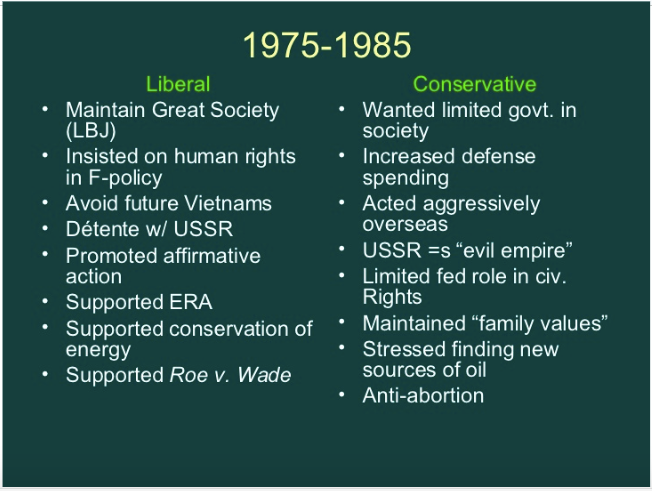Review Activity for the P7-P9 APUSH Need-to-Know Proper Nouns
With a focus on the twenty most important proper nouns mentioned in the CED’s P1-P3 Key Concepts
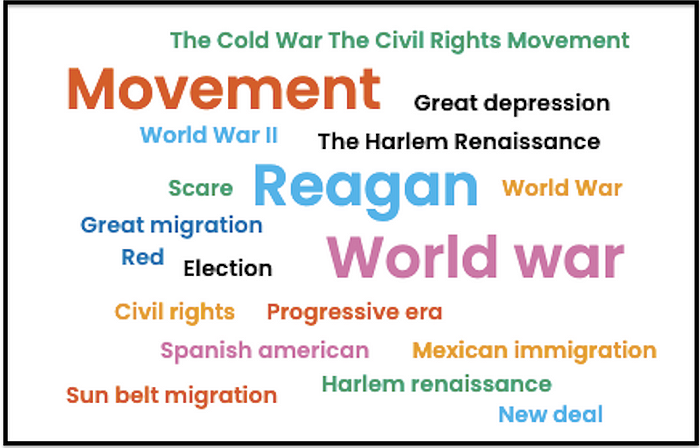
The APUSH Course and Exam Description (CED) mentions many proper nouns. To excel on the May exam, it is crucial for students to become familiar with these proper nouns. They show up time and again.
To help my students learn what they need to learn as it relates to these proper nouns, I have created this blog post.
The post lists each proper noun mentioned in the CED (for Periods 7–9) and also provides the relevant language that “houses” these nouns. Additionally, for each proper noun, I have included one or more short answer questions to help students better understand the nouns’ significance and relevance to the APUSH exam.
In the weeks leading up to the exam, I will have my students work in small groups to answer each of the SAQs found within this post. By doing this, I am confident that my students will be able to better focus their studies and thereby increase their chances of success on the APUSH exam.
The Spanish American War
The American victory in the Spanish–American War led to the U.S. acquisition of island territories in the Caribbean and the Pacific, an increase in involvement in Asia, and the suppression of a nationalist movement in the Philippines.
- Briefly describe ONE reason why the United States became involved in the Spanish-American War.
- Briefly describe ONE outcome of the American victory in the Spanish-American War in terms of U.S. territorial expansion.
- Briefly describe ONE example of increased U.S. involvement in Asia as a result of the Spanish-American War.
- Briefly describe ONE way in which the Spanish-American War led to the suppression of a nationalist movement.
- Briefly describe ONE criticism of U.S. imperialism that arose in the wake of the Spanish-American War.
- Briefly describe ONE significant difference between the territory acquired as a result of the Spanish American War and the territory acquired as a result of the Mexican Cession.
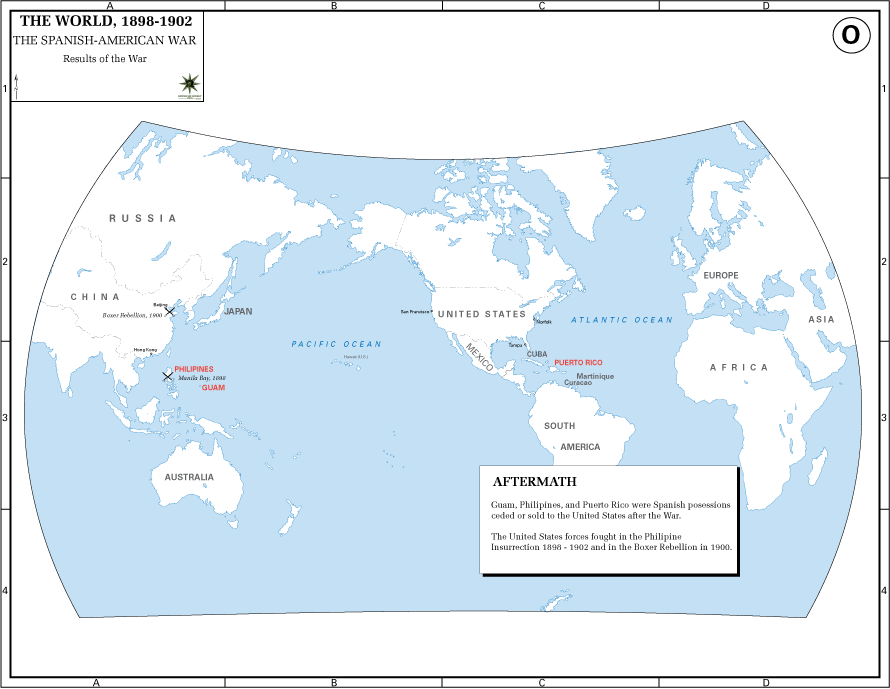
The Progressive Era
In the Progressive Era of the early 20th century, Progressives responded to political corruption, economic instability, and social concerns by calling for greater government action and other political and social measures.
Some Progressive Era journalists attacked what they saw as political corruption, social injustice, and economic inequality, while reformers, often from the middle and upper classes and including many women, worked to effect social changes in cities and among immigrant populations.
On the national level, Progressives sought federal legislation that they believed would effectively regulate the economy, expand democracy, and generate moral reform. Progressive amendments to the Constitution dealt with issues such as prohibition and woman su rage.
Preservationists and conservationists both supported the establishment of national parks while advocating different government responses to the overuse of natural resources.
The Progressives were divided over many issues. Some Progressives supported Southern segregation, while others ignored its presence. Some Progressives advocated expanding popular participation in government, while others called for greater reliance on professional and technical experts to make government more efficient. Progressives also disagreed about immigration restriction.
- Briefly describe ONE political concern that motivated Progressive Era reformers.
- Briefly describe ONE social concern that motivated Progressive Era reformers.
- Briefly describe ONE specific government action that Progressives called for in response to political corruption during the Progressive Era.
- Briefly describe ONE example of social injustice that Progressive Era journalists attacked.
- Briefly describe ONE economic issue that Progressives sought to regulate through federal legislation during the Progressive Era.
- Briefly describe ONE Progressive Era amendment to the Constitution.
- Briefly describe ONE example of social change that Progressive reformers worked to effect in cities during the Progressive Era.
- Briefly describe ONE difference between the perspectives of preservationists and conservationists during the Progressive Era.
- Briefly describe ONE issue that divided Progressives during the Progressive Era, particularly in relation to race and ethnicity.
- Briefly describe ONE Progressive Era proposal for expanding democracy, and explain its significance.
- Briefly describe ONE example of disagreement among Progressives regarding immigration restriction during the Progressive Era.

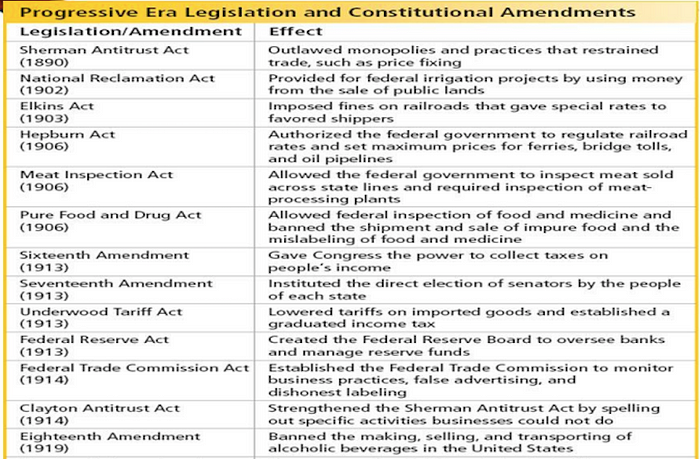
World War I
During and after World War I, nativist campaigns against some ethnic groups led to the passage of quotas that restricted immigration, particularly from southern and eastern Europe, and increased barriers to Asian immigration.
After initial neutrality in World War I, the nation entered the conflct, departing from the U.S. foreign policy tradition of noninvolvement in European affairs, in response to Woodrow Wilson’s call for the defense of humanitarian and democratic principles.
Although the American Expeditionary Forces played a relatively limited role in combat, the U.S.’s entry helped to tip the balance of the conflict in favor of the Allies.
The increased demand for war production and labor during World War I led many Americans to migrate to urban centers in search of economic opportunities.
Official restrictions on freedom of speech grew during World War I, as increased anxiety about radicalism led to a Red Scare and attacks on labor activism and immigrant culture.
World War I and its aftermath intensified ongoing debates about the nation’s role in the world and how best to achieve national security and pursue American interests.
Despite Wilson’s deep involvement in post (World War I) negotiations, the U.S. Senate refused to ratify the Treaty of Versailles or join the League of Nations.
In the years following World War I, the United States pursued a unilateral foreign policy that used international investment, peace treaties, and select military intervention to promote a vision of international order, even while maintaining U.S. isolationism.
- Briefly describe ONE factor that contributed to the passage of quotas restricting immigration during and after World War I.
- Briefly describe ONE effect of the U.S.’s entry into World War I on the conflict.
- Briefly describe ONE situation that led many Americans to migrate to urban centers during World War I.
- Briefly describe ONE example of how official restrictions on freedom of speech increased during World War I.
- Briefly describe ONE development that intensified ongoing debates about the nation’s role in the world after World War I.
- Briefly describe ONE reason why the U.S. Senate refused to ratify the Treaty of Versailles or join the League of Nations.
- Briefly describe ONE outcome of the United States' unilateral foreign policy in the years following World War I.
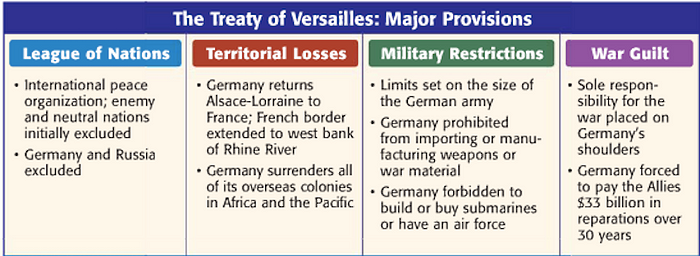
The Great Migration
In a Great Migration during and after World War I, African Americans escaping segregation, racial violence, and limited economic opportunity in the South moved to the North and West, where they found new opportunities but still encountered discrimination.
- Briefly describe ONE factor that contributed to the Great Migration of African Americans from the South to the North in the early 20th century.
- Briefly describe ONE reason why African Americans left the South during the Great Migration.
- Briefly describe ONE outcome of the Great Migration for African Americans who migrated to the North.
- Briefly describe ONE result of the Great Migration for Southern agriculture and economy.
- Briefly describe ONE situation that pushed African Americans to leave the South and migrate to the North during the Great Migration.
- Briefly describe ONE cause of the demographic shift that occurred in many Northern cities as a result of the Great Migration.
- Briefly describe ONE significant difference between the opportunities available to African Americans in the North compared to the South during the Great Migration.
- Briefly describe ONE similarity between the experiences of African American migrants during the Great Migration and those of other immigrant groups.
- Briefly describe ONE significant factor that contributed to the decline of the Great Migration in the mid-20th century.

The Harlem Renaissance
Migration gave rise to new forms of art and literature that expressed ethnic and regional identities, such the Harlem Renaissance movement.
- Briefly describe ONE reason why Harlem became a center for African American culture during the Harlem Renaissance.
- Briefly describe ONE outcome of the Harlem Renaissance for African American artists and writers.
- Briefly describe ONE result of the Harlem Renaissance for the wider American culture.
- Briefly describe ONE significant difference between the opportunities available to African American artists and writers during the Harlem Renaissance and in the preceding era.
The Red Scare
Official restrictions on freedom of speech grew during World War I, as increased anxiety about radicalism led to a Red Scare and attacks on labor activism and immigrant culture.
- Briefly describe ONE reason why the fear of communism took hold in the United States during the Red Scare.
- Briefly describe ONE outcome of the Red Scare for American politics and society.
- Briefly describe ONE US Supreme Court case relating to the Red Scare.
- Briefly describe ONE significant difference between the treatment of suspected communists during the First Red Scare and the Second Red Scare.
The Great Depression
Episodes of credit and market instability in the early 20th century, in particular the Great Depression, led to calls for a stronger financial regulatory system.
During the 1930s, policymakers responded to the mass unemployment and social upheavals of the Great Depression by transforming the U.S. into a limited welfare state, redefining the goals and ideas of modern American liberalism.
- Briefly describe ONE factor that contributed to the episodes of credit and market instability in the early 20th century, including the Great Depression.
- Briefly describe ONE outcome of the transformation of the U.S. into a limited welfare state in response to the Great Depression.
- Briefly describe ONE way that the transformation of the U.S. into a limited welfare state redefined the goals and ideas of modern American liberalism in response to the Great Depression.
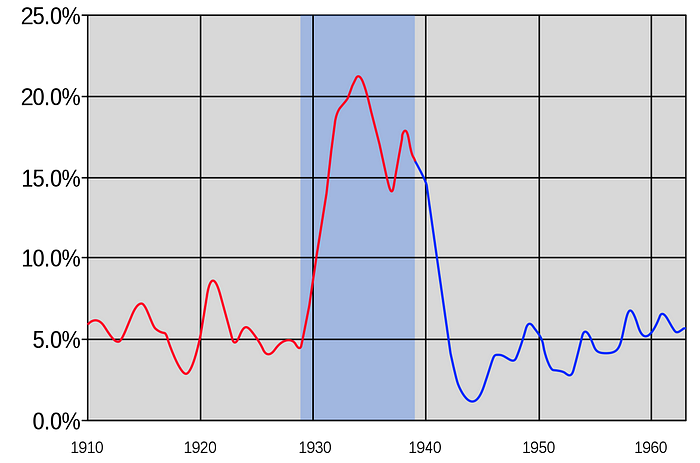
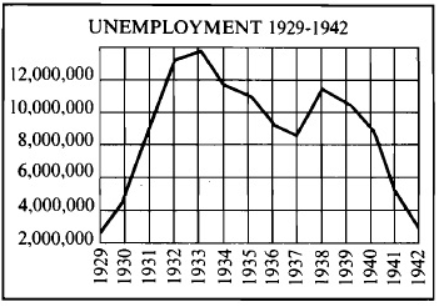
The New Deal
Franklin Roosevelt’s New Deal attempted to end the Great Depression by using government power to provide relief to the poor, stimulate recovery, and reform the American economy.
Radical, union, and populist movements pushed Roosevelt toward more extensive efforts to change the American economic system, while conservatives in Congress and the Supreme Court sought to limit the New Deal’s scope.
Although the New Deal did not end the Depression, it left a legacy of reforms and regulatory agencies and fostered a long-term political realignment in which many ethnic groups, African Americans, and working-class communities identifed with the Democratic Party.
- Briefly describe ONE goal of Franklin Roosevelt’s New Deal.
- Briefly describe ONE example of a movement that pushed Roosevelt toward more extensive efforts to change the American economic system.
- Briefly describe ONE example of a conservative effort to limit the scope of the New Deal.
- Briefly describe ONE way that the New Deal attempted to provide relief to the poor.
- Briefly describe ONE way that the New Deal attempted to stimulate economic recovery.
- Briefly describe ONE way that the New Deal attempted to reform the American economy.
- Briefly describe ONE outcome of the New Deal’s efforts to change the American economic system during the Great Depression.
- Briefly describe ONE way that the New Deal left a legacy of reforms and regulatory agencies.
- Briefly describe ONE way that the New Deal fostered a long-term political realignment in American politics.
- Briefly describe ONE significant difference between the New Deal and the Great Society, and explain its significance.
- Briefly describe ONE significant difference between Ronald Reagan’s domestic policies and those of the New Deal, and explain its significance.

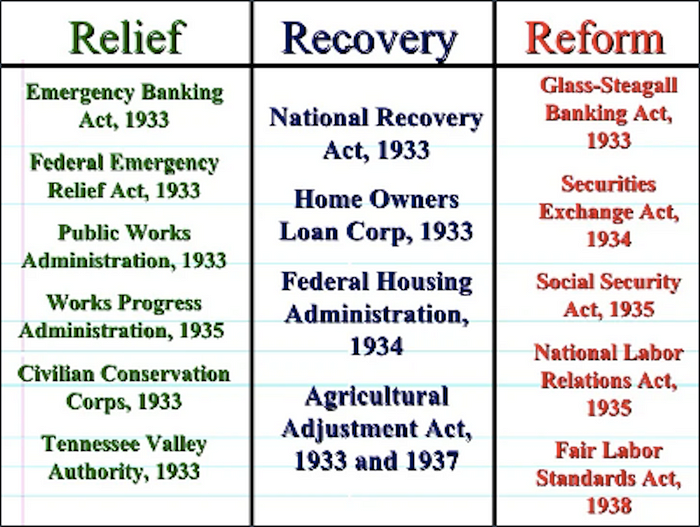
World War II
In the 1930s, while many Americans were concerned about the rise of fascism and totalitarianism, most opposed taking military action against the aggression of Nazi Germany and Japan until the Japanese attack on Pearl Harbor drew the United States into World War II.
U.S. participation in World War II transformed American society, while the victory of the United States and its allies over the Axis powers vaulted the U.S. into a position of global, political, and military leadership.
Americans viewed the war as a fight for the survival of freedom and democracy against fascist and militarist ideologies. This perspective was later reinforced by revelations about Japanese wartime atrocities, Nazi concentration camps, and the Holocaust.
The mass mobilization of American society helped end the Great Depression, and the country’s strong industrial base played a pivotal role in winning the war by equipping and provisioning allies and millions of U.S. troops.
Mobilization and military service provided opportunities for women and minorities to improve their socioeconomic positions for the war’s duration, while also leading to debates over racial segregation. Wartime experiences also generated challenges to civil liberties, such as the internment of Japanese Americans
The United States and its allies achieved military victory through Allied cooperation, technological and scientific advances, the contributions of servicemen and women, and campaigns such as Pacific “island- hopping” and the D-Day invasion. The use of atomic bombs hastened the end of the war and sparked debates about the morality of using atomic weapons.
The war-ravaged condition of Asia and Europe, and the dominant U.S. role in the Allied victory and postwar peace settlements, allowed the United States to emerge from the war as the most powerful nation on earth
The United States responded to an uncertain and unstable post (World Waer II) world by asserting and working to maintain a position of global leadership, with far-reaching domestic and international consequences.
- Briefly describe ONE reason why many Americans opposed taking military action against Nazi Germany and Japan in the 1930s.
- Briefly describe ONE example of how U.S. participation in World War II transformed American society.
- Briefly describe ONE outcome of the U.S. victory in World War II for the country’s global position.
- Briefly describe ONE way that Americans viewed World War II as a fight for democracy and freedom.
- Briefly describe ONE example of a revelation that reinforced Americans’ perspective on World War II.
- Briefly describe ONE way that the mass mobilization of American society helped end the Great Depression.
- Briefly describe ONE example of how women and minorities improved their socioeconomic positions during World War II.
- Briefly describe ONE way that the wartime experiences generated challenges to civil liberties.
- Briefly describe ONE factor that contributed to the Allied victory in World War II.
- Briefly describe ONE campaign that contributed to the Allied victory in World War II.
- Briefly describe ONE example of how the use of atomic bombs hastened the end of the war.
- Briefly describe ONE debate sparked by the use of atomic bombs in World War II.
- Briefly describe ONE way that the United States emerged from World War II as the most powerful nation on earth.
- Briefly describe ONE response of the United States to the uncertain and unstable post-World War II world.
- Briefly describe ONE domestic or international consequence of the United States’ assertion and maintenance of global leadership after World War II.

Mexican Immigration
Migration to the United States from Mexico and elsewhere in the Western Hemisphere increased, in spite of contradictory government policies toward Mexican immigration.
- Briefly describe ONE reason why migration to the United States from Mexico and elsewhere in the Western Hemisphere increased, despite contradictory government policies.
- Briefly describe ONE example of a contradictory government policy toward Mexican immigration.
- Briefly describe ONE outcome of Mexican immigration to the United States for both the migrants and the country as a whole.
- Briefly describe ONE significant difference between Mexican immigration to the United States and Chinese immigration to the United States.
The Cold War
United States policymakers engaged in a cold war with the authoritarian Soviet Union, seeking to limit the growth of Communist military power and ideological in uence, create a free-market global economy, and build an international security system.
As postwar tensions dissolved the wartime alliance between Western democracies and the Soviet Union, the United States developed a foreign policy based on collective security, international aid, and economic institutions that bolstered non-Communist nations.
Concerned by expansionist Communist ideology and Soviet repression, the United States sought to contain communism through a variety of measures, including major military engagements in Korea and Vietnam.
The Cold War uctuated between periods of direct and indirect military confrontation and periods of mutual coexistence (or détente).
Postwar decolonization and the emergence of powerful nationalist movements in Asia, Africa, and the Middle East led both sides in the Cold War to seek allies among new nations, many of which remained nonaligned.
Cold War competition extended to Latin America, where the U.S. supported non-Communist regimes that had varying levels of commitment to democracy
Cold War policies led to public debates over the power of the federal government and acceptable means for pursuing international and domestic goals while protecting civil liberties.
(During the Cold War) Americans debated policies and methods designed to expose suspected communists within the United States even as both parties supported the broader strategy of containing communism.
Although anticommunist foreign policy faced little domestic opposition in previous years, the Vietnam War inspired sizable and passionate antiwar protests that became more numerous as the war escalated and sometimes led to violence.
Americans debated the merits of a large nuclear arsenal, the military-industrial complex, and the appropriate power of the executive branch in conducting foreign and military policy.
Ideological, military, and economic concerns shaped U.S. involvement in the Middle East, with several oil crises in the region eventually sparking attempts at creating a national energy policy.
- Briefly describe ONE goal of United States policymakers during the Cold War in relation to the Soviet Union.
- Briefly describe ONE foreign policy that the United States developed in response to postwar tensions with the Soviet Union.
- Briefly describe ONE way that the United States sought to contain communism during the Cold War.
- Briefly describe ONE example of direct military confrontation during the Cold War.
- Briefly describe ONE example of mutual coexistence (or detente) during the Cold War.
- Briefly describe ONE way that postwar decolonization and nationalist movements affected Cold War competition.
- Briefly describe ONE way that Cold War competition extended to Latin America.
- Briefly describe ONE public debate that Cold War policies led to in the United States.
- Briefly describe ONE policy or method designed to expose suspected communists within the United States during the Cold War.
- Briefly describe ONE example of a significant antiwar protest in response to the Vietnam War.
- Briefly describe ONE debate among Americans during the Cold War about the merits of a large nuclear arsenal.
- Briefly describe ONE way that the military-industrial complex shaped U.S. involvement in the Cold War.
- Briefly describe ONE example of ideological concerns shaping U.S. involvement in the Middle East during the Cold War.
- Briefly describe ONE way that economic concerns shaped U.S. involvement in the Middle East during the Cold War.
- Briefly describe ONE outcome of oil crises in the Middle East during the Cold War for U.S. energy policy.
The Civil Rights Movement
New movements for civil rights and liberal efforts to expand the role of government generated a range of political and cultural responses
Seeking to ful ll Reconstruction-era promises, civil rights activists and political leaders achieved some legal and political successes in ending segregation, although progress toward racial equality was slow.
During and after World War II, civil rights activists and leaders, most notably Martin Luther King Jr., combatted racial discrimination utilizing a variety of strategies, including legal challenges, direct action, and nonviolent protest tactics.
The three branches of the federal government used measures including desegregation of the armed services, Brown v. Board of Education, and the Civil Rights Act of 1964 to promote greater racial equality.
Continuing resistance slowed efforts at desegregation, sparking social and political unrest across the nation. Debates among civil rights activists over the efficacy of nonviolence increased after 1965.
Responding to social conditions and the African American civil rights movement, a variety of movements emerged that focused on issues of identity, social justice, and the environment.
Feminist and gay and lesbian activists mobilized behind claims for legal, economic, and social equality.
Latino, American Indian, and Asian American movements continued to demand social and economic equality and a redress of past injustices.
- Briefly describe ONE cultural response to new movements for civil rights and liberal efforts to expand the role of government.
- Briefly describe ONE political response to new movements for civil rights and liberal efforts to expand the role of government.
- Briefly describe ONE example of a legal or political success achieved by civil rights activists and political leaders in ending segregation.
- Briefly describe ONE strategy used by civil rights activists and leaders, most notably Martin Luther King Jr., to combat racial discrimination during and after World War II.
- Briefly describe ONE measure used by the three branches of the federal government to promote greater racial equality.
- Briefly describe ONE way that continuing resistance slowed efforts at desegregation and sparked social and political unrest across the nation.
- Briefly describe ONE debate among civil rights activists over the efficacy of nonviolence after 1965.
- Briefly describe ONE way that social conditions and the African American civil rights movement gave rise to other movements focused on issues of identity, social justice, and the environment.
- Briefly describe ONE claim made by feminist activists in their mobilization behind legal, economic, and social equality.
- Briefly describe ONE example of a movement that demanded social and economic equality and a redress of past injustices among Latino, American Indian, or Asian American communities.
- Briefly describe ONE outcome of the African American civil rights movement for the United States as a whole.
The Great Society
Liberal ideas found expression in Lyndon Johnson’s Great Society, which attempted to use federal legislation and programs to end racial discrimination, eliminate poverty, and address other social issues. A series of Supreme Court decisions expanded civil rights and individual liberties.
- Briefly describe ONE liberal idea that found expression in Lyndon Johnson’s Great Society.
- Briefly describe ONE goal of the Great Society in relation to ending racial discrimination.
- Briefly describe ONE goal of the Great Society in relation to eliminating poverty.
- Briefly describe ONE social issue that the Great Society attempted to address through federal legislation and programs.
- Briefly describe ONE way in which a series of Supreme Court decisions expanded civil rights and individual liberties during the era of the Great Society.
The Vietnam War
- Briefly describe ONE example of an antiwar protest that occurred during the Vietnam War.
- Briefly describe ONE effect of the Gulf of Tonkin Resolution on the United States’ involvement in the Vietnam War.
- Briefly describe ONE military action taken by the North Vietnamese during the Vietnam War, which is commonly referred to as the Tet Offensive.
- Briefly describe ONE aspect of Operation Rolling Thunder, a sustained bombing campaign conducted by the United States in North Vietnam.
- Briefly describe ONE outcome of the bombing of Cambodia during the Vietnam War.
- Briefly describe ONE effect of the Kent State shooting on public opinion about the Vietnam War.
- Briefly describe ONE example of a war crime committed by United States military personnel during the Vietnam War.
- Briefly describe ONE way in which the Vietnam War impacted the soldiers who fought in it.
- Briefly describe ONE consequence of the Vietnam War for Vietnam itself.
- Briefly describe ONE consequence of the Vietnam War for the United States as a whole.
- Briefly describe ONE similarity between Lyndon Johnson’s Vietnam War policy and Richard Nixon’s Vietnam War policy
- Briefly describe ONE difference between Lyndon Johnson’s Vietnam War policy and Richard Nixon’s Vietnam War policy
The Environmental Movement
Environmental problems and accidents led to a growing environmental movement that aimed to use legislative and public efforts to combat pollution and protect natural resources. The federal government established new environmental programs and regulations.
- Briefly describe ONE environmental problem or accident that contributed to the growth of the environmental movement.
- Briefly describe ONE goal of the environmental movement in relation to combating pollution.
- Briefly describe ONE example of a new environmental program or regulation established by the federal government in response to the environmental movement.
The Sun Belt Migration
The Sun Belt region emerged as a signi cant political and economic force.
- Briefly describe ONE reason why the Sun Belt region emerged as a significant economic force.
- Briefly describe ONE example of a political change that occurred in the Sun Belt region as a result of migration.
- Briefly describe ONE outcome of Sun Belt migration for the United States as a whole.
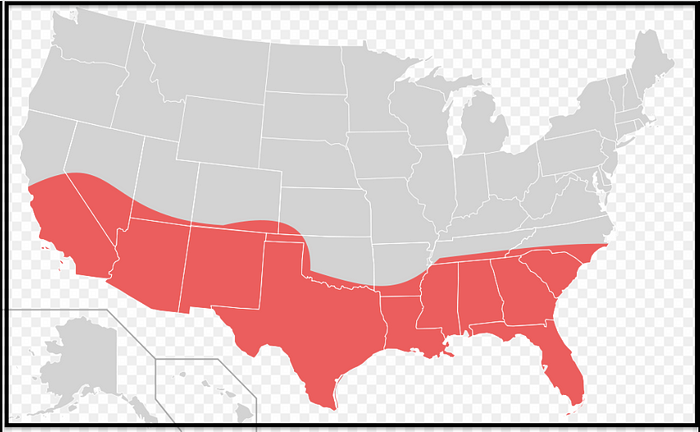

The Election of Reagan
Ronald Reagan’s victory in the presidential election of 1980 represented an important milestone, allowing conservatives to enact signi cant tax cuts and continue the deregulation of many industries.
Conservatives argued that liberal programs were counterproductive in ghting poverty and stimulating economic growth. Some of their e orts to reduce the size and scope of government met with inertia and liberal opposition, as many programs remained popular with voters.
Policy debates continued over free-trade agreements, the scope of the government social safety net, and calls to reform the U.S. nancial system.
A newly ascendant conservative movement achieved several political and policy goals during the 1980s and continued to strongly influence public discourse in the following decades.
Conservative beliefs regarding the need for traditional social values and a reduced role for government advanced in U.S. politics after 1980.
- Briefly describe ONE important milestone represented by Ronald Reagan’s victory in the presidential election of 1980.
- Briefly describe ONE argument made by conservatives against liberal programs in fighting poverty and stimulating economic growth.
- Briefly describe ONE example of inertia or liberal opposition to conservative efforts to reduce the size and scope of government.
- Briefly describe ONE policy debate that continued during Ronald Reagan’s presidency.
- Briefly describe ONE outcome of the newly ascendant conservative movement during the 1980s.
